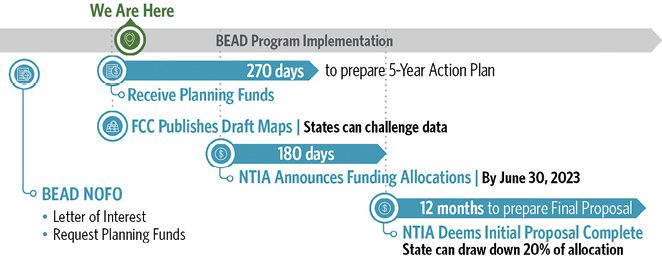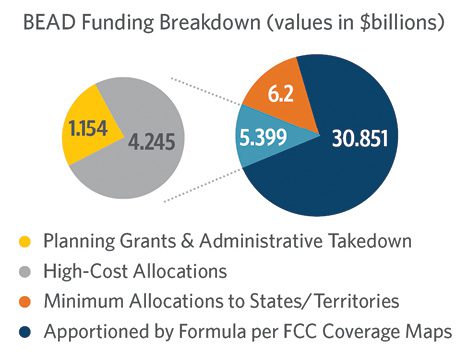How to Navigate Federal Policy and Expedite Action Plans and Proposals to Meet Requirements

The Infrastructure Investment and Jobs Act (IIJA) provides more than $42 billion to states to support broadband deployment to those without access to fast, reliable internet. The recent pandemic confirmed a digital divide separates those who can effectively participate in our increasingly online world and those who can’t. The Broadband Equity Access and Deployment (BEAD) program in the IIJA provides funds to states to help bridge that divide, and, in 2023, all U.S. states and territories will complete their plans to implement a BEAD program in their jurisdiction, customized to access needs of their residents.
In this “Q&A” feature, Eric Beightel, a principal consultant for infrastructure policy and environmental strategy in HDR’s Advisory Services practice, outlines key issues that states are addressing to improve equity in broadband access while he frames the timing for decisions states need to make as they roll out their IIJA-funded broadband investments.
Q. What’s next with the BEAD program?
A. There are a number of procedural requirements in the BEAD program—a series of milestones that states must hit to unlock the full funding available. The first milestone is complete because all 50 states submitted their letters of interest to participate in the BEAD program and have requested planning funds to support development of the required Five-Year Action Plan. The action plans are due to the National Telecommunications Information Administration (NTIA) within 270 days of the state’s receipt of planning funds, and NTIA is releasing those funds on a rolling basis.
NTIA expects to provide states with their BEAD funding allocations (to actually build out their broadband infrastructure) by June 30, 2023, using the most up-to-date FCC coverage maps (more on the maps a little later). That kicks off another countdown clock for states to develop their initial proposal within 180 days. If NTIA deems their initial proposal complete, states can then draw down 20 percent of their implementation funding allocation. To access the final 80 percent of implementation funds, states must then prepare a final proposal.
It’s a lot of processes, but each step builds on the previous one and allows states to access at least a portion of the funding as they progress through the steps. I think it’s ingenious—and I don’t often describe legislation as ingenious.
Q. What are the biggest challenges states are grappling with? Can you give examples of questions states need to answer for themselves as they shape their programs?
A. It’s fair to say that some of the requirements can challenge state broadband offices that are recently created and still maturing. For example, money that states received under the American Rescue Plan Act (ARPA) of 2021 has an approaching spending deadline many states are trying to meet. These new BEAD requirements are coming at them while they’re still trying to meet ARPA deadlines.
The 270-day timeline to develop the five-year action plan is a challenge as well. Although most states have done some of the work necessary to satisfy the 13 required elements of the action plan, few have done it all and many are bringing in outside expertise to help.
Although it’s an aggressive timeline, there’s a path to success if you break it down into phases and ask yourself:
• What are my existing conditions? Start by assessing the current conditions within the state, including the current funding available and the human resources available to deliver a massive broadband program, what existing physical infrastructure is available to support deployment as well as what challenges or obstacles exist. This sets the stage for the rest of the plan and is an opportunity to look critically at how the state’s assets currently are positioned. For example, when describing the existing structure of the agency to administer grants, states can start to assess how they will build out their organization, what skills are lacking, and how they will ultimately oversee and implement the grant program. This is a place where outside consultants can share ideas that have worked for other similar programs.
• Where are my gaps? After you have a handle on what you have, it’s time to figure out where you have digital access gaps and start the process to prioritize how to fill those gaps. Are there areas that could be considered low-hanging fruit because they just need a little help to reach everyone? Or is it better to prioritize larger remote areas that could take longer to reach? Each state will make its own determination based on its own unique needs.

• How do we close these gaps to reach the unserved and underserved? Finally, understanding all of that, it’s time to map out the process to achieve universal service (or as close as possible). All of the above must be done with full consideration of stakeholder input. The BEAD program requires coordination among the state and cities and counties as well as coordination with the required Statewide Digital Equity Plan.
Q. What should everyone understand about how funding levels will be apportioned to states?
A. On Nov. 18, 2022, the Federal Communications Commission published draft broadband maps (broadbandmap.fcc.gov/home) that detail the current locations of unserved and underserved households. This is important, because these maps are the basis for the formula used to determine allocations of BEAD funds. Now that the maps are available, states may choose to challenge the FCC’s data if they believe it undercounts the number of unserved or underserved households within the state—and try to get more BEAD funding.
There is some higher math involved in the NTIA funding formulas, and how it all works isn’t widely understood.
Just more than $1 billion is designated for planning grants and administrative costs for the Department of Commerce to implement the program. Another $4.245 billion is set aside for high-cost allocations (what NTIA defines as locations disproportionately expensive to deploy infrastructure).

Then $37.356 billion goes to the states and territories for BEAD implementation. Each state (and D.C. and Puerto Rico) is guaranteed at least $100 million, and the territories of American Samoa, Guam, U.S. Virgin Islands and the Commonwealth of the Northern Mariana Islands are guaranteed at least $25 million—all totaling $6.2 billion.
The remaining $31.156 billion is apportioned by NTIA based on the proportion of unserved and underserved in a state compared to the number of unserved and underserved in the nation as a whole, according to the FCC coverage maps.
For example, suppose there are 10 million unserved households in the United States and “State A” has 100,000 unserved within its borders. That state would expect to receive 1 percent of the $31.156 billion (roughly $311 million). Because funding is based on a proportion of unserved/underserved in a state compared to the national total, you can see why it’s so important to get the mapping information correct. If the FCC undercounts the number of underserved in a state, that state’s BEAD funding would be insufficient.

Q. With overlapping timelines for the action plan and the initial proposal, what strategies should states consider to be efficient with their time in meeting these requirements?
A. Everything states say in their five-year action plan should be developed with an eye toward what’s required in the initial proposal. For example, as states establish priorities for investment, they should be working with those localities to make sure the communities and providers are aligned and ready to apply for grant funds.
NTIA’s requirements on how the grant funds are used and when service must be operational are clearly stated in the law and the notice of funding. This means states will need processes in place to track grant funds and report back to the federal government on how those funds are being used and if they’re meeting performance requirements. All of that can be daunting for agencies unaccustomed to such large grant programs with so many potential grantees. Because of this, it’s important to start designing the grant award and monitoring process as part of the action plan. Provide a framework in the action plan that can be further fleshed out in the initial proposal to support efficient and effective management of the funds and federal requirements.
Similarly, states should consider opportunities to build partnerships with the private sector to maximize cost-effective deployment and reduce the burden on the state. Since those partnerships take time and expertise to negotiate, states might benefit by bringing in outside help. I’d advise starting those discussions early as part of the action plan, if they haven’t already, so they have a framework as part of the initial proposal.
Q. What is the most important takeaway from all of this?
A. It’s important to take a step back from all of this process and policy and remember that the work we’re doing to deploy broadband and increase connectivity will substantially improve the lives of the millions of Americans without access. It’s easy to take internet access for granted because it’s ubiquitous for much of the population—but one-fourth of our rural population and one-third of our tribal populations lack access to fast, reliable internet. This very real digital divide creates inequities and barriers to opportunity because internet connectivity is integrated into so much of our daily lives for communication, entertainment, healthcare, employment, accessing government services, and so on.
BEAD is about elevating everyone to enable equal participation in modern society. It’s about breaking down obstacles that prevent folks from connecting—whether that be affordability issues, lack of understanding, lack of infrastructure or anything else. That’s what’s so rewarding about this work we’re doing—it can truly make a difference for so many people.
About Eric Beightel
Eric Beightel is a principal infrastructure policy strategist at HDR; email: [email protected].


